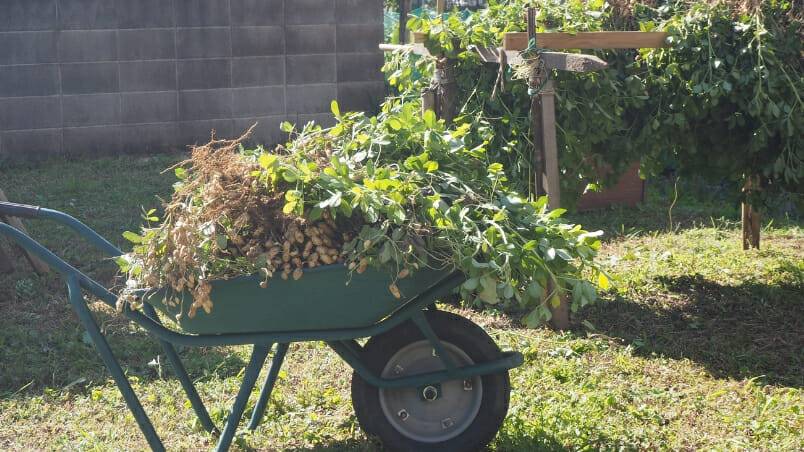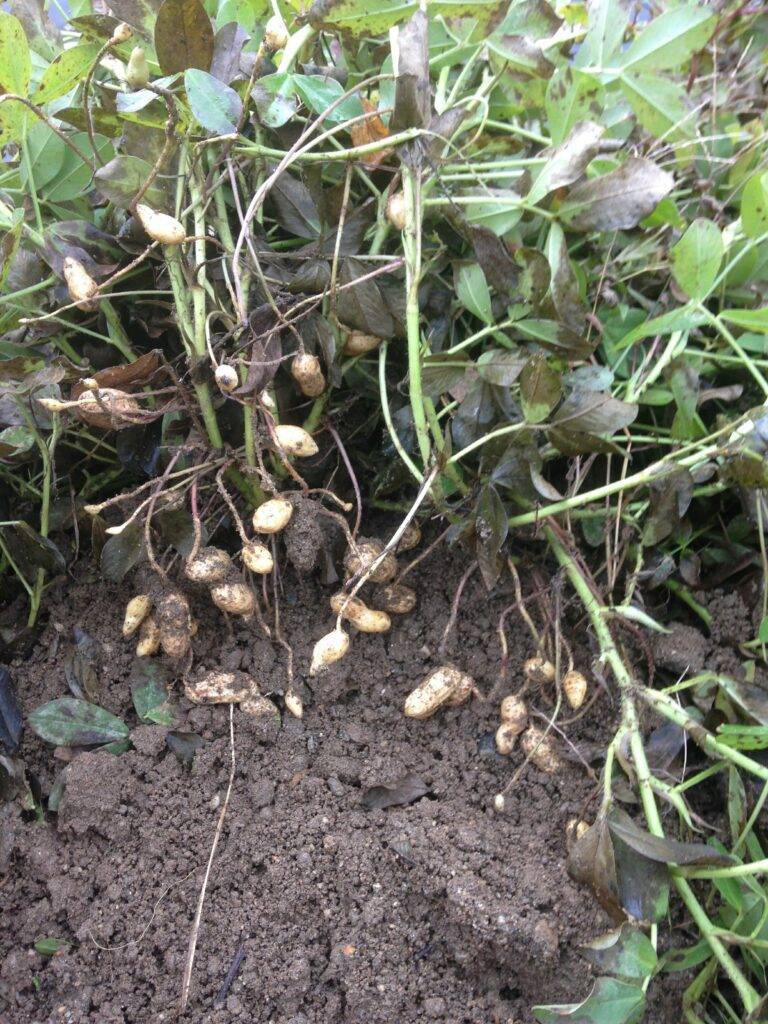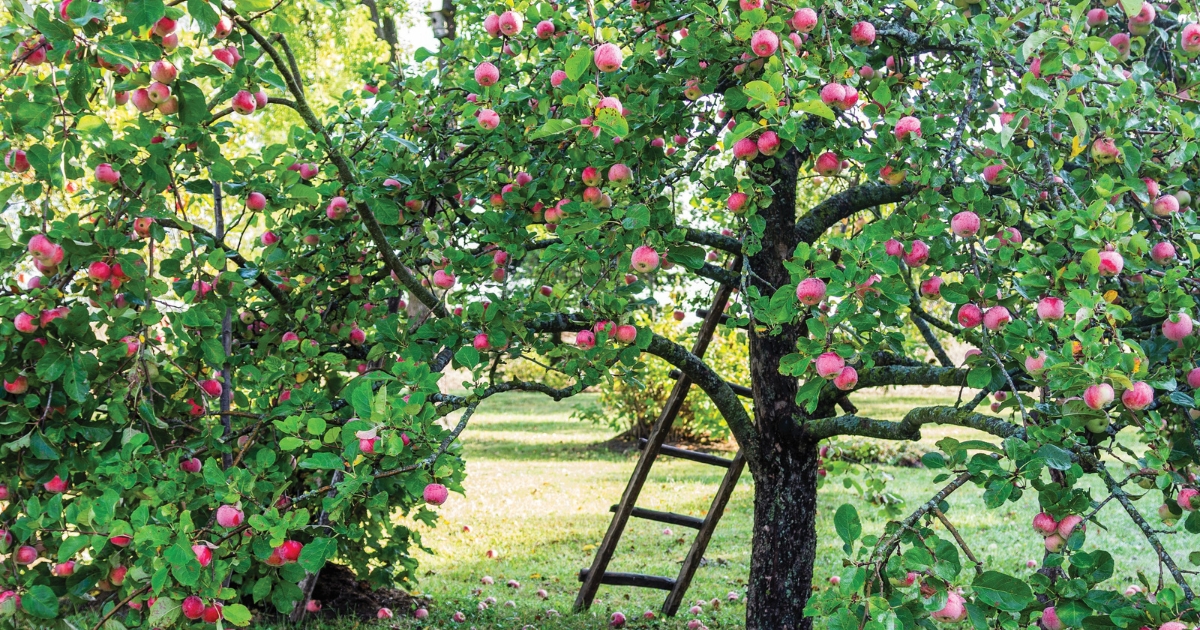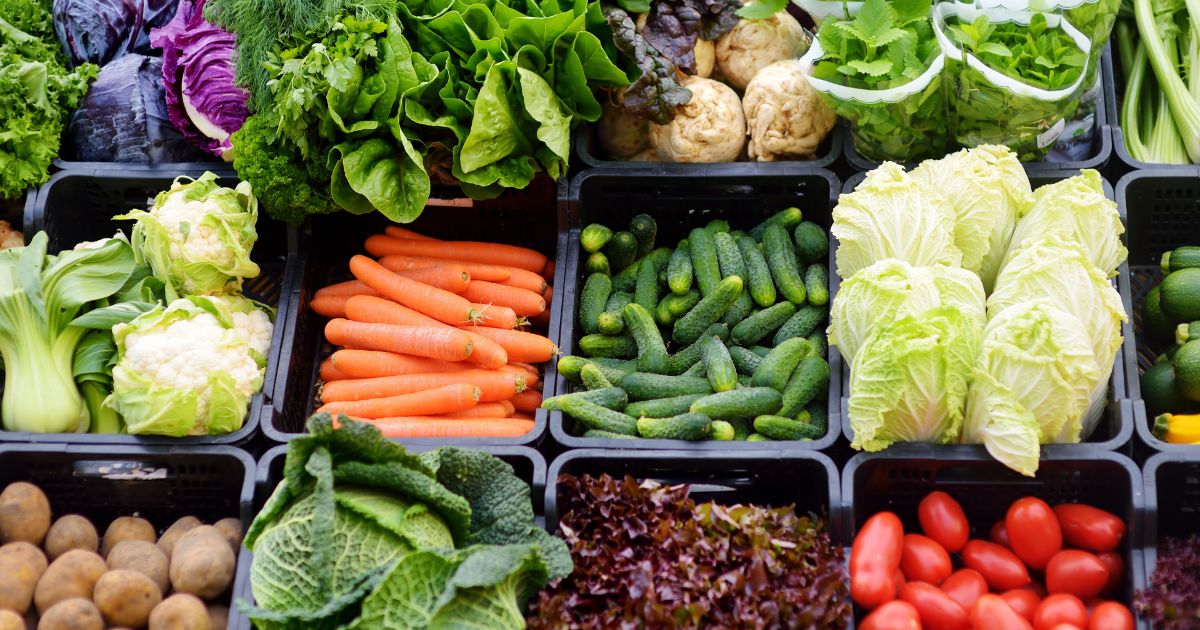Technically, a peanut is a legume, from the fabaceae or pea/bean family, but it looks, tastes and packs all the nutritional power of a nut. The scientific name from the often repetitive binominal nomenclature created by Swedish Botanist, Carl Linneaus (1707-1778) is arachis hypnogaea. Arachis, meaning underground ripening pod, and hypo, which is a Greek prefix meaning below, and gaea, meaning earth.
- A diagram of the peanut plant, Arachis hypogaea from Köhler’s Medizinal-Pflanzen-163.jpg., created 1st January 1887 (Public Domain)
- Peanuts freshly pulled from the ground. (Jon Davis)
Most Canadians associate the peanut with the Southern United States, President Jimmy Carter, and plantations. Hence many assume that, like watermelons, they originated in Africa, and were transplanted during the slave trade. However, like potatoes and tomatoes, the peanut has its roots in South America, though it was brought to West Africa, replacing the native bambara groundnut, by the same historical forces that brought it to modern North American farmers: European colonialism and trade, which sadly included slave-based agriculture.
The peanut originated in North Western Argentina well over 8,000 years ago. It spread east and north along the prehistoric trade routes that we now know existed 12,500 years ago, between the Andes and coastal South America, long before the advent of agriculture. It’s in Peru that we find the first record of peanut domestication, 7,600 years ago, though it’s likely cultivation started earlier in South East Bolivia. Peanuts can be found represented in art among the various early pre-Columbian cultures that eventually culminated in the Incan civilization, such as in Moche vases from around AD 100.
It’s thought to have spread to Mexico along the same trade routes that brought corn down from Central America to Peru, and although we have no exact dates, it may have been as early as 6,700 years ago. What we can say for sure is that peanuts were widespread across the Americas by 2,500 BC, and well-established as a crop when the conquistadors destroyed Aztec civilization in 1521. The Spanish adopted the Nahuatl name for peanut Tlalcacahuatl or cacahuate in Mexican Spanish, hence the French cacahuète.
European trade and colonization then brought peanuts to West Africa, Asia and the United States. In Africa it spread eastward across the Sahel region. According to the USDA, as of 2018, Nigeria was the world’s fourth top grower, producing 1.5 million metric tons. Senegal, Ghana and Chad make up another 1.5 tons of the world’s 30 million ton peanut production. China ranks first at 13.4 million tons, India second at 7.7, followed by Indonesia, and Burma at 1.13 and .7 respectively. Thus, the U.S.A. is third (1.8) and Argentina, where it originated, is 10th in world production at .42 million metric tons.
I started growing peanuts after I got my third piece of land, when Yamamoto-san, another weekend farmer died and his wife asked me to take care of part of their property for her. Her late husband, a civil servant, had always experimented with new ways of doing things. He had stressed the importance of this to me many times. He did things such as adding soaked strips of newspaper in the trenches beneath the sweet potato seedlings before covering with soil, to prevent them from drying out in the hot summer sun. For peanuts, he and his wife taught me that a simple stringing of fishing line over the plants is enough to deter birds, who love to dig up both the freshly planted and the mature legumes. In Canada, squirrels and raccoons may prove to be formidable adversaries.
- A brown-eared bulbul juvenile sits on the fishing line frame built to protect the peanuts from birds. (Keith Adams)
- A row of halfway grown peanut bushes protected by fishing line. (Keith Adams)
The method for planting peanuts is similar to planting other legumes; simply save a few beans – or in this case, peanuts – when you harvest, or buy seed peanuts when you first give it a try. Like most legumes, make an impression with a jar on the soil mound at distances of 30 cm. Plant about three peanuts to the hole, pointy end up. Cover with soil, then thin out the weakest shoots after the sprouts break ground. Being a legume, they fix their own nitrogen, so there is no need for extra fertilizer.
Peanuts prefer sandy, loamy, well-drained soil, in full sun. In the right spot, these low-maintenance, slow-growers, will bush out well, covering the mound, smothering most weeds and helping to retain moisture.
Planted in mid- to late-May, peanuts are harvested in late October or early November; that’s a five to six month growing period, but the harvest is well worth the wait. To harvest, the entire plant is pulled out of the ground; the peanuts cling to the plant’s roots. Some say it’s important to carefully dig up the plant, because when simply torn from the ground, you risk losing some peanuts. However, I find them to be fairly tough, and most hang on. Any that do fall off are quickly gathered with a light raking.
- Pulling plant from the ground. (Jon Davis)
- Peanuts freshly pulled from the ground. (Jon Davis)
As the soil falls away from the roots, a magical tree-like structure appears with hundreds of beans and nodules forming linked, bubbly scales along the roots. It always makes me think of a line from James Joyce’s Ulysses: “The heaven tree of stars hung with humid night-blue fruit.”
- A revealed underground universe of beans and nodules. (Keith Adams)
- A revealed underground universe of beans and nodules. (Keith Adams)
After pulling, the peanut plant is hung upside down to dry on a simple frame, and after a week in the autumn sun, I pluck the peanuts off the plant, and place them on newspaper-lined trays. These I store for a few weeks more outside in my legume-drier – a small structure with a transparent roof – where they will get the sun, but not the rain. Then, usually in December, when I am too tired to do school work, I shell the peanuts by hand while watching QI (Questions of Intelligence) on YouTube.
- Hanging up peanut plants to dry on a laundry rack. (Jon Davis)
- Wheel barrow full of peanuts and a simple wooden drying rack. (Jon Davis)
- Peanuts in their paper-lined tray being put in drying rack (Keith Adams)
- A row of peanut trays in the drying rack. (Keith Adams)
While the peanut has become a mainstay of many Asian cuisines, such as Thai Satay or as a topping on Vietnamese noodles like pho ga, here in Japan it remains largely a snack food to be eaten with beer. Indeed, the only Japanese peanut recipe I could dig up was from Setsuko Watanabe’s cookbook, Stone Soup; Easy Japanese Home Cooking, for lightly fried peanuts covered in miso paste and roasted; in short, snack food.
- Peanut & You! Typical kakipi or peanut snacks in Japan: Peanuts with seaweed wrapped sembe; miso paste covered peanuts, and mixed dried beans. Often they will also include tiny dried fish called jacko. (Keith Adams)
- Peanut snacks and Yebisu beer. And yes, that is the average head on a Japanese pint! Like most Canadians I used to consider that amount of foam a criminal offense, but have since learned that the foam represents a release of C02 from the beer, so you are not swallowing all that gas. (Keith Adams)
Although not a traditional food, many Japanese farmers grow peanuts in their gardens because as a legume it is a good nitrogen fixer and increases the fertility of the soil. The nitrogen is packed in the nodules that grow along the roots. I began to grow peanuts out of curiosity and simply because I could. Further, I make my own trail mix, which is largely non-existent in Japan. Similarly, peanut butter is sold only in “European” stores and looked down upon as an unhealthy, disgusting, and fattening American food. Fair enough; 100 grams of peanuts pack 570 calories.

It’s a relationship between the nodules on the peanut roots and a helpful bacteria that fix nitrogen into the soil.
If you remove the salt, sugars and hydrogenated oils found in many processed peanut butters, it’s extremely healthy. One hundred grams of peanuts provides 25 grams of protein, 20% RDI of vitamins B and E, 95% manganese, 52% magnesium, 48% phosphorous and fiber, 15 % iron, 35% zinc and 7% potassium. The lowly peanut packs more nutrition than most tree nuts. Peanuts are also considered healthy for the brain, nervous, and cardiovascular systems, and while the term “peanut brain” is shorthand for “stupid”, eating peanuts is now believed to be extremely good for brainpower and overall health.
One quarter cup of peanuts contains 26 mg of biotin, a B vitamin which is thought to improve brain cell connectivity. In addition, it is believed that biotin can be used to help treat multiple sclerosis, and diabetes, while it also significantly lowers the risk of congenital birth defects. Like red wine, peanuts also contain resveratrol, which increases blood flow to the brain and is thought to lower the risk of strokes. Further peanuts contain copper – ¼ cup provides 47% of what we need in a day – which helps to power the enzymes responsible for energy production and creation of the myelin sheath that protects axons, thus increasing the speed of neural transmissions. It may also help to prevent neurodegenerative diseases such as Alzheimer’s and Parkinson’s.
Ah, but what about all those fattening calories, you say? The copper present in peanuts also lowers levels of harmful LDL cholesterol. Peanut fat is 80% unsaturated, like olive oil, and these are the healthy kind that are believed to promote blood flow and clearing of the arteries, helping to lower the risk of heart attack. So, barring a peanut allergy, this unassuming little ground nut’s bad image is highly underserved.
I grow two rows of about 15 meters in length, planted with about 20-25 plants each, and that provides me with four to five large jars of shelled nuts, which will last about six months, give or take. I usually eat these raw, cooked in a stir-fry, tossed in my oatmeal, or mixed in my trail mix. I think I will have to double my production, however, to end up with a full year’s supply and to make some real headway re: increased brainpower.
Keith is an environmentalist, university lecturer, musician, author, and organic farmer. His Master’s thesis on Roman Agriculture in North Africa, is from Concordia University, where he taught Roman history and Greek mythology, as well as writing and study skills. For over two decades, Keith has lived in Japan where he teaches academic writing, debate and social studies at three universities; plays three times a month with his band, Roman Rhodes and the Born Again Pagans; and of course, gardens. He is currently working on a book about farming in Japan, focusing on its traditional methods’ benefits to the environment and the absolute necessity of the small farm to our survival.



































